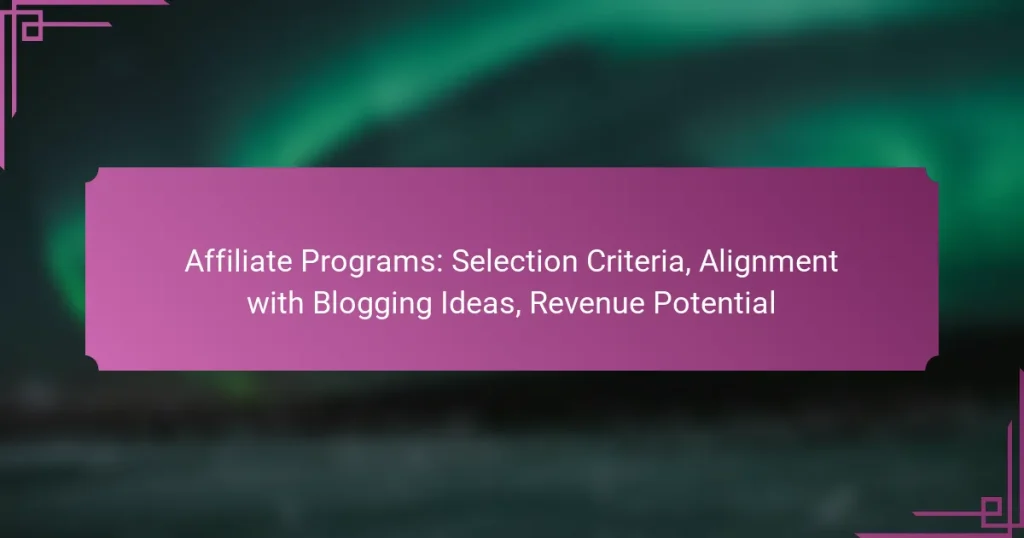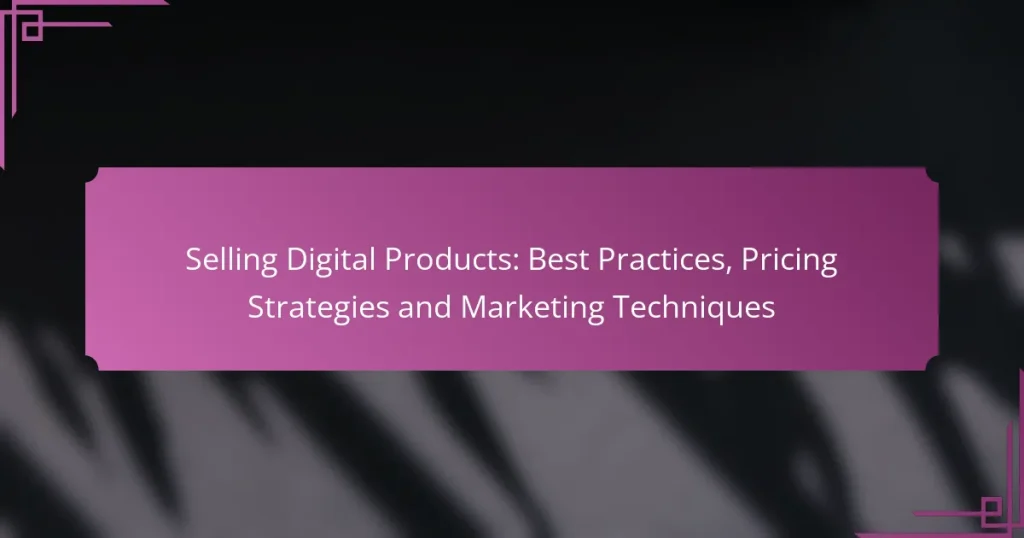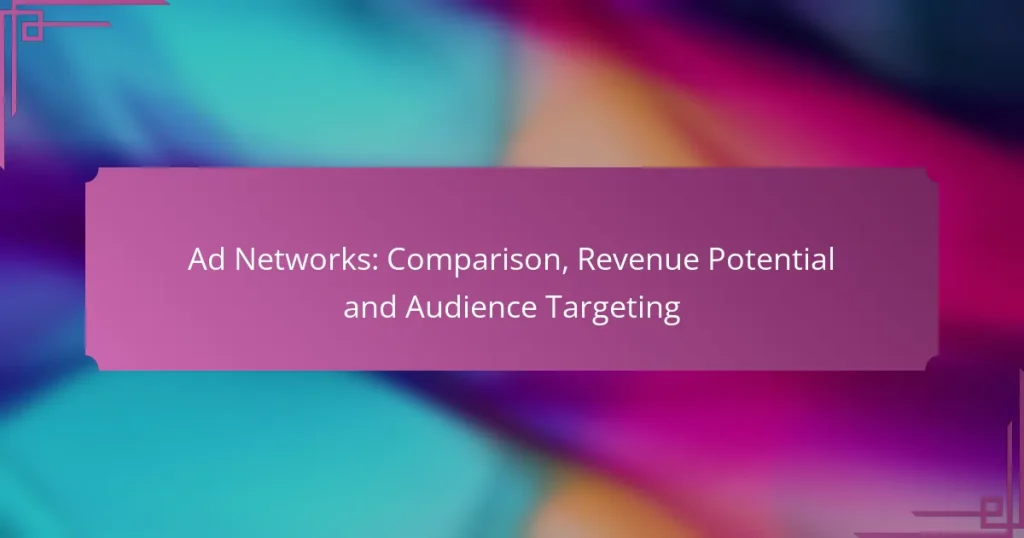Monetizing a blog effectively requires a strategic approach tailored to your audience and niche. Popular methods include display advertising, affiliate marketing, sponsored content, subscription models, and selling digital products. Each strategy presents unique opportunities and challenges, allowing bloggers to optimize their revenue streams while maintaining audience engagement.
Monetization Strategies: Affiliate Programs, Sponsored Content, Digital Products, Membership Models, Ad Networks
Patreon: Exclusive Content, Subscriber Benefits and Revenue Growth
Sponsored Content: Opportunities, Engagement Strategies and Revenue Generation
Selling Digital Products: Best Practices, Pricing Strategies and Marketing Techniques
Membership Models: Recurring Revenue, Subscriber Engagement and Content Value
Ad Networks: Comparison, Revenue Potential and Audience Targeting
What are effective monetization strategies for blogs?
Effective monetization strategies for blogs include display advertising, affiliate marketing, sponsored content, subscription models, and selling digital products. Each method has its own advantages and considerations, allowing bloggers to choose the best fit for their audience and niche.
Display advertising with Google AdSense
Display advertising through Google AdSense allows bloggers to earn revenue by placing ads on their sites. When visitors click on these ads, the blog owner receives a portion of the advertising revenue. It’s essential to have a steady flow of traffic to maximize earnings, as revenue is typically based on impressions and clicks.
To optimize earnings, bloggers should focus on creating high-quality content that attracts visitors and encourages them to stay longer. Additionally, experimenting with ad placements and formats can help increase visibility and click-through rates.
Affiliate marketing partnerships
Affiliate marketing involves partnering with companies to promote their products or services, earning a commission for each sale generated through unique referral links. This strategy works best when bloggers choose products that align with their content and resonate with their audience.
To succeed in affiliate marketing, bloggers should disclose their partnerships to maintain transparency and trust with their readers. Creating detailed product reviews or tutorials can also enhance credibility and encourage conversions.
Sponsored content collaborations
Sponsored content collaborations involve working with brands to create posts that promote their products or services in exchange for payment. This can include articles, videos, or social media posts that highlight the brand’s offerings while fitting seamlessly into the blog’s theme.
When pursuing sponsored content, it’s crucial to maintain authenticity and only collaborate with brands that align with the blog’s values. Clear disclosure of sponsorships is also necessary to comply with advertising regulations and maintain reader trust.
Subscription-based models
Subscription-based models allow bloggers to offer premium content or services to their audience for a recurring fee. This can include exclusive articles, videos, or access to a community forum. By providing valuable content, bloggers can encourage readers to subscribe for ongoing benefits.
To implement a successful subscription model, bloggers should consider offering a free trial or tiered pricing to attract new subscribers. Regularly updating content and engaging with subscribers can help retain them over time.
Digital product sales
Selling digital products, such as e-books, online courses, or printables, can be a lucrative monetization strategy for bloggers. These products often require an initial investment of time and effort but can generate passive income once created.
Bloggers should focus on creating high-quality, valuable products that address the needs of their audience. Marketing these products effectively through the blog and social media channels is essential for driving sales and maximizing revenue potential.
How can display advertising maximize revenue?
Display advertising can significantly enhance blog revenue by leveraging visual ads that attract user attention. By partnering with ad networks and optimizing ad placements, bloggers can generate consistent income streams while maintaining user engagement.
Utilizing ad networks like Mediavine
Ad networks such as Mediavine provide a platform for bloggers to connect with advertisers, streamlining the process of monetization. These networks typically require a minimum traffic threshold, often around 25,000 monthly sessions, to join, ensuring that only established blogs benefit from premium ad placements.
Once accepted, Mediavine manages the ad inventory, optimizing for the highest possible revenue based on your audience’s demographics and behavior. This allows bloggers to focus on content creation while the network maximizes ad performance.
Optimizing ad placements for visibility
Effective ad placement is crucial for maximizing revenue from display advertising. Ads should be strategically positioned within the content, such as above the fold or within the first few paragraphs, to capture attention without disrupting the reading experience.
Consider A/B testing different placements to determine which configurations yield the highest click-through rates (CTR). Common placements include in-content ads, sidebar banners, and sticky ads that remain visible as users scroll. Aim for a balance that maintains user engagement while enhancing visibility.
What are the benefits of affiliate marketing for bloggers?
Affiliate marketing offers bloggers a way to earn income by promoting products or services and receiving a commission for each sale made through their referral. This strategy not only generates revenue but also allows bloggers to provide value to their audience by recommending relevant products.
Passive income generation
One of the main advantages of affiliate marketing is the potential for passive income. Once a blog post containing affiliate links is published, it can continue to generate revenue over time without additional effort. This means that bloggers can earn money while focusing on creating new content or other projects.
To maximize passive income, bloggers should choose evergreen topics that remain relevant and optimize their posts for search engines. Regularly updating content and links can also help maintain traffic and conversions.
Diverse product offerings
Affiliate marketing allows bloggers to promote a wide range of products and services, catering to various interests and niches. This diversity enables bloggers to tailor their recommendations to their audience’s preferences, increasing the likelihood of conversions.
When selecting affiliate programs, bloggers should consider products that align with their content and audience. For example, a travel blog might promote travel gear, booking services, or travel insurance. By focusing on relevant offerings, bloggers can enhance their credibility and trust with their readers.
How to choose the right affiliate programs?
Choosing the right affiliate programs involves evaluating commission structures and ensuring the products align with your audience’s interests. This strategic selection can significantly impact your blog’s revenue potential and audience engagement.
Evaluating commission structures
When assessing affiliate programs, consider the commission rates offered. Most programs provide a percentage of the sale, typically ranging from 5% to 50%, depending on the product type and market. Higher commission rates can lead to increased earnings, but also consider the average order value to gauge potential income.
Additionally, examine the payment terms and frequency. Some programs pay monthly, while others may have thresholds that need to be met before payouts. Understanding these details helps you manage cash flow effectively.
Assessing product relevance to audience
Product relevance is crucial for successful affiliate marketing. Choose products that resonate with your blog’s niche and audience interests. For instance, a tech blog should promote gadgets or software, while a health blog might focus on wellness products.
To evaluate relevance, consider conducting surveys or analyzing audience demographics. This data can guide your selection of affiliate programs, ensuring that the products you promote are likely to convert into sales.
What role does sponsored content play in blog monetization?
Sponsored content is a significant monetization strategy for blogs, allowing creators to generate income by partnering with brands. This approach involves creating content that promotes a brand’s products or services while providing value to readers.
Building brand partnerships
Establishing strong partnerships with brands is crucial for effective sponsored content. Bloggers should seek out companies that align with their niche and audience interests. A well-matched partnership can lead to long-term collaborations, enhancing credibility and income potential.
When approaching brands, provide a media kit that outlines your blog’s audience demographics, engagement metrics, and previous successful campaigns. This information helps brands understand the value of partnering with you.
Enhancing content value for readers
Sponsored content should be crafted to enrich the reader’s experience rather than detract from it. Focus on creating informative, engaging articles that seamlessly integrate the brand’s message. This approach maintains reader trust while fulfilling the sponsorship requirements.
Consider including practical tips, product reviews, or tutorials that highlight the brand’s offerings. For example, if promoting a kitchen appliance, share recipes or cooking techniques that utilize the product, making the content relevant and useful to your audience.
What are the prerequisites for successful blog monetization?
Successful blog monetization requires a solid foundation of audience engagement and high-quality content. Without these elements, generating revenue through your blog becomes significantly more challenging.
Establishing a loyal audience
Building a loyal audience is crucial for monetization. Engage with your readers by responding to comments, encouraging feedback, and creating a community around your blog. This connection fosters trust and encourages repeat visits.
Consider utilizing social media platforms to promote your blog and interact with your audience. Regularly sharing updates and insights can help maintain interest and attract new followers, ultimately expanding your reach.
Creating high-quality content consistently
Consistent, high-quality content is essential for retaining your audience’s attention and attracting new visitors. Focus on providing valuable information that addresses your readers’ needs and interests. Aim for clarity and depth in your writing to establish authority in your niche.
Develop a content calendar to help you plan and maintain a steady flow of posts. This strategy can keep your audience engaged and improve your blog’s search engine ranking, which is vital for visibility and monetization opportunities.






